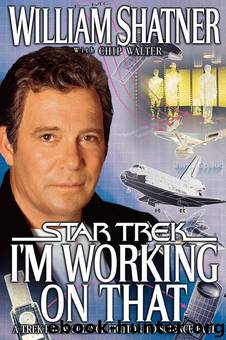I'm Working on That by William Shatner & Chip Walter

Author:William Shatner & Chip Walter
Language: eng
Format: epub
Publisher: Gallery Books
Published: 2002-08-02T00:00:00+00:00
The original Kurzweil Reading Machine. It solved the thorny character recognition problem that plagued artificial intelligence researchers back in 1978. Kurzweil’s first customer was Stevie Wonder.
Looking at him I could buy that—a compact man with wiry, gray hair and a confident calmness, almost a shyness, that I imagined might have characterized a younger Einstein. (He combs his hair better than Albert did, though.)
The evidence of Kurzweil’s considerable talent and drive was all around. The Kurzweil Reading Machine, the first general purpose, commercial optical character recognition (OCR) machine. It hit the market in 1978. The Kurzweil 250 Music Synthesizer, the first machine to successfully re-create the sounds of a grand piano, electronically (1984). The Kurzweil 3000 Reading Machine, a next-generation computer system that can scan text and images and then read them back to blind or learning disabled people in a voice that actually sounds quite human (1996). There were even a couple of computers run by Kurzweil software that produce pretty good artwork and poetry.
Looking at all of this innovation, I had to ask Ray, “Why?”
“Well, it goes back to pattern recognition again,” says Ray. “I specialize in developing software and computers that recognize all kinds of patterns whether they’re in sound waves that make up human speech or visual patterns that make up printed language. It turns out that ninety-nine percent of human intelligence is pattern recognition. We’re excellent at it. That’s the great strength of the human brain. Like I said, it’s been an interest of mine going back to high school.”
Ray’s Got a Secret
A lot of high school scientific fascinations end up revealed in science fairs, usually as tabletop volcanoes or small-time Tesla coils, but not Ray’s. His were revealed on national television, on a show called I’ve Got a Secret. For those of you too young to remember this show, first, curse you and your youth. Second, let me fill you in.
I’ve Got a Secret was an enormously popular television game show way back in the last century in the fifties and early sixties. Basically it was twenty questions with celebrities. Someone would come on the show, like Ray, and state their secret for the host. At the same time, the secret was also revealed to everyone in the studio audience as well as the millions of people watching at home. On stage, opposite the show’s host, sat four celebrities who would ask the guest a series of yes or no questions, whatever came into their well-known heads. If they kept getting “yes” answers, they could keep asking questions. If they got a “no,” on to the next celebrity
So here we are in the early 1960s, a few years before Star Trek even aired its first episode, and a teenage Kurzweil walks out onto the stage, sits down, and plays a composition on an old upright piano. When he’s done, he walks over and whispers his secret into the ear of Steve Allen, the show’s host at that time.
“I built my own computer,” he says.
“Well, that’s
Download
This site does not store any files on its server. We only index and link to content provided by other sites. Please contact the content providers to delete copyright contents if any and email us, we'll remove relevant links or contents immediately.
| Automotive | Engineering |
| Transportation |
Whiskies Galore by Ian Buxton(41532)
Introduction to Aircraft Design (Cambridge Aerospace Series) by John P. Fielding(32890)
Small Unmanned Fixed-wing Aircraft Design by Andrew J. Keane Andras Sobester James P. Scanlan & András Sóbester & James P. Scanlan(32574)
Craft Beer for the Homebrewer by Michael Agnew(17935)
Turbulence by E. J. Noyes(7702)
The Complete Stick Figure Physics Tutorials by Allen Sarah(7143)
Kaplan MCAT General Chemistry Review by Kaplan(6597)
The Thirst by Nesbo Jo(6439)
Bad Blood by John Carreyrou(6278)
Modelling of Convective Heat and Mass Transfer in Rotating Flows by Igor V. Shevchuk(6225)
Learning SQL by Alan Beaulieu(6037)
Weapons of Math Destruction by Cathy O'Neil(5832)
Man-made Catastrophes and Risk Information Concealment by Dmitry Chernov & Didier Sornette(5650)
Digital Minimalism by Cal Newport;(5392)
Life 3.0: Being Human in the Age of Artificial Intelligence by Tegmark Max(5189)
iGen by Jean M. Twenge(5163)
Secrets of Antigravity Propulsion: Tesla, UFOs, and Classified Aerospace Technology by Ph.D. Paul A. Laviolette(4994)
Design of Trajectory Optimization Approach for Space Maneuver Vehicle Skip Entry Problems by Runqi Chai & Al Savvaris & Antonios Tsourdos & Senchun Chai(4843)
Electronic Devices & Circuits by Jacob Millman & Christos C. Halkias(4749)
